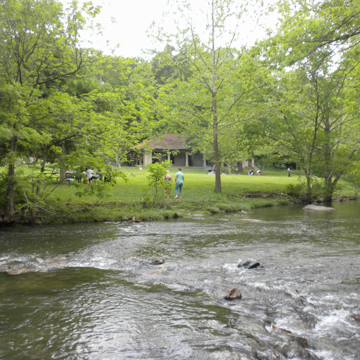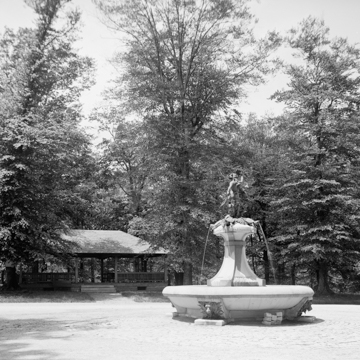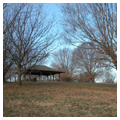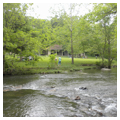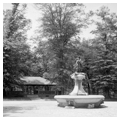Cherokee Park, designed in 1891, is perhaps the most scenic of Frederick Law Olmsted’s Louisville parks. Located to the east of the city, in the then new suburbs of Louisville, the 409-acre park lies within a rolling valley along Beargrass Creek, which is crossed by numerous pedestrian and automobile bridges. A serpentine, 2.4-mile scenic loop meanders down sloping hills to the valley floor and back up again. Footpaths and old bridle trails bring the visitor to the edge of a limestone ledge or trace, up to the highest hill in the park, which is marked by the rustic Barringer Hill shelter (rebuilt) and down and along the meandering creek bed to Big Rock Shelter House (1910, William J. Dodd). Two sculptures by Enid Yandell grace the park: Daniel Boone (1893) stands at the Eastern Parkway entrance, while a lively bronze sculpture of the Greek god Pan adorns a dog and horse watering basin (1905), known as Hogan’s Fountain. A large picnic shelter, evocative of a Native American tipi and designed by Edward Jacob Schickli Jr., was installed across the road from Hogan’s Fountain in 1965.
The park was threatened in the 1960s with the construction of Interstate 64, which cut through the northern end of the park. Activists succeeded in having two tunnels built under Cochran Hill in order to preserve the bridle trail and beech grove above. A 1974 tornado destroyed eighty percent of Cherokee Park’s hardwood trees, which in turn increased erosion and the proliferation of non-native invasive species. Since 1994, the Olmsted Parks Conservancy has been working to restore Cherokee Park, along with the other Olmsted-designed landscapes throughout Louisville.
References
Haragan, Patricia Dalton. The Olmsted Parks of Louisville. Lexington: University Press of Kentucky, 2014.
Rademacher Susan M. “A Living Legacy: Louisville’s Olmsted Landscapes.” In Louisville Guide,edited by Gregory A. Luhan, Dennis Domer, and David Mohney. New York: Princeton Architectural Press, 2004.


